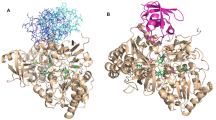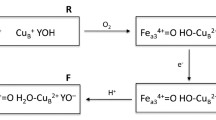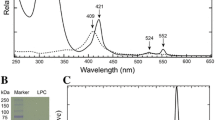Abstract
The thermodynamic model of five interacting charge centres (four haems and an ionisable centre), which was used in the characterisation of the thermodynamic properties of Desulfovibrio vulgaris (Hildenborough) cytochrome c 3 (c 3DvH), is now used to reevaluate the thermodynamic properties in Desulfovibrio vulgaris (Miyazaki F) cytochrome c 3 (c 3DvM) on the basis of published data (Park, J.-S., Ohmura, T., Kano, K., Sagara, T., Niki, K., Kyogoku, Y. and Akutsu, H. (1996) Biochim. Biophys. Acta 1293, 45–54). Contrary to the assertion of Park et al. (1996), the pH dependence of the proton chemical shifts of haem methyls in c 3DvM in several stages of oxidation is well described by the model, which involves both homotropic (e–/e–) and heterotropic (e–/H+) cooperativity. This shows that the pH dependence observed for c 3DvM is not significantly more complicated than that observed for c 3DvH. Since the parameters which we now obtain for c 3DvM are generated with the same model as those from c 3DvH, albeit using less precise data, it is possible to make a preliminary comparison of the thermodynamic properties of these two proteins and of their role in energy transduction.
The extrinsic dipolar shifts generated for each methyl group by each of the four haems in c 3DvM are also determined. A novel method for approximating the magnetic susceptibility tensors is used: the orientations of the principal axes of the tensors have been shown to be closely related to the geometry of the axial ligands, which is available from the X-ray structure of c 3DvM, and the components of the tensors are extrapolated from EPR g values. The inclusion of the calculated haem extrinsic contributions clearly describes the pH dependence of the haem methyls in the core of the protein, close to other haems. This description is most remarkable in the case of the haem methyl 21CH3 II I, for which the "unusual pH dependence" commented on by Park et al. (1996) is easily explained using the thermodynamic parameters determined by our model together with the calculated extrinsic dipolar shifts, thus providing a test of the analysis.
Similar content being viewed by others
Author information
Authors and Affiliations
Additional information
Received: 15 January 1997 / Accepted: 20 March 1997
Rights and permissions
About this article
Cite this article
Salgueiro, C., Turner, D., Gall, J. et al. Reevaluation of the redox and redox-Bohr cooperativity in tetrahaem Desulfovibrio vulgaris (Miyazaki F) cytochrome c 3 . JBIC 2, 343–349 (1997). https://doi.org/10.1007/s007750050141
Issue Date:
DOI: https://doi.org/10.1007/s007750050141




